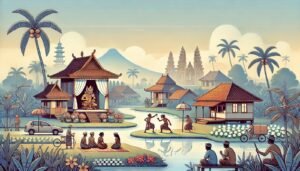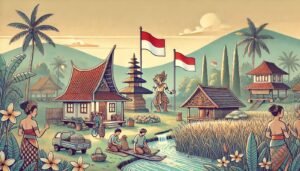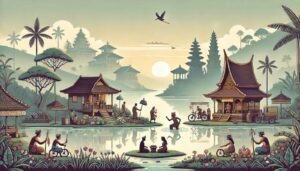By : Ngurah Sigit.
The life of the Nusantara people, from ancient times to the present, cannot be separated from the wealth of symbols deeply rooted in every aspect of life. These symbols not only serve as a means of communication but also represent the values, norms, and beliefs held by the various ethnic groups and communities across the Nusantara. In this diverse culture, symbols take on various forms, from language, architecture, clothing, to traditional rituals, each carrying profound meanings that can only be understood within the socio-cultural context of the people.

One example of symbolism in Nusantara society is found in traditional customs and religious ceremonies. In Bali, for instance, Hindu communities often use natural symbols in their religious rituals, such as flowers, water, and fire, representing various forces of nature and spirituality. Additionally, traditional clothing worn during these ceremonies is rich with symbolism. Every element, from color to design, holds its own significance, whether in supporting spiritual balance or expressing social status.
In Java, symbols are also prominent in traditional performing arts like wayang kulit (shadow puppetry). Wayang is not merely a form of entertainment but also a medium for conveying moral lessons and life philosophies. Each character in wayang represents specific values, such as wisdom, justice, or greed. The Punakawan, the clown-servant characters, are often seen as symbols of the common people, who, despite their humble appearance, possess profound wisdom.

Beyond spiritual and artistic aspects, symbols are also present in the everyday lives of the Nusantara people. For instance, in traditional houses, each part of the building often carries symbolic meaning. The Minangkabau traditional house, with its curved horn-shaped roof, symbolizes the buffalo’s horn, representing strength and glory. In Sulawesi, the Tongkonan house of the Toraja people is not merely a place of residence but a symbol of social status and ancestral heritage, highly revered by the community.
Symbols in the life of the Nusantara people can also be seen in the use of language. Many proverbs and traditional sayings are rich in symbolism, reflecting the worldview and values upheld by society. Phrases like “berakit-rakit ke hulu, berenang-renang ke tepian” (endure hardship before reaching success) not only speak of patience and hard work but also imply the life journey filled with challenges before attaining happiness.
In the modern context, Nusantara’s cultural symbols have continued to thrive, although they have undergone adaptations. Batik, recognized by UNESCO as an intangible cultural heritage, remains a symbol of Indonesian identity. The motifs used in batik are not only aesthetically pleasing but are also filled with philosophical meanings that reflect the worldview and spirituality of the people.

The life of the Nusantara people, rich with symbols, demonstrates that the culture is not only focused on the physical and material aspects but is also imbued with deep meaning and spirituality. These symbols serve as a bridge connecting the past and present, creating a unique identity for the Indonesian people amidst the changing times.
The outhor is a sociologist, cultural observer, and media analyst.

